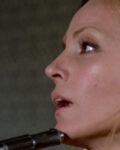CD: Golden Child, The (1986)
Return to: Home / Soundtrack Reviews / G
.
Label: La-La Land Records/ Released: July 12, 2011
Tracks & Album Length: CD1: 25 tracks / (77:14) + CD2: 23 tracks / (58:07) + CD3: 9 tracks / (30:17)
.
Special Notes: 28-page colour booklet with liner notes by Jon Burlingame / Limited to 5000 copies.
.
Composers: John Barry, Michel Colombier
.
.
Review:
Like La-La Land’s decision to release a 3-disc set for Basil Poledouris’ dual Breakdown [M] (1997) scores, this monster set boasts several hours of music, but more importantly, it gathers together two distinct scores, of which one was largely used in the final release version.
Jon Burlingame’s liner notes detail the troubled production which, incredibly, became a box office hit after scenes were trimmed, cut, and reshot, and John Barry’s music score was replaced in favour of a new work by Michel Colombier.
Replacing a score has tended to be Hollywood’s solution to last-minute problem solving when a film tests poorly with audiences, but in hearing the two scores back-to-back, it does become obvious Barry’s approach went against the film’s tone as it evolved into a more urban-styled comedy.
Barry stuck with a big orchestral sound, and unfortunately, sections of his cues tend to loop the same material, such as the flaring brass in “The Child is Taken,” which becomes the score’s tense action theme and is heard far too often in the longer cues with little variation.
Barry was asked to rescore the picture after the film’s editing had been locked, but in addition to scheduling issues, one suspects the composer had little desire to revisit and overhaul an approach he felt was correct. The descending figure first heard in “2M1” (most of his cues lack formal titles) is quite arresting, and it’s unsurprising it formed the basis of a love theme, performed by his trademark combo of sultry sax and lush strings. Barry also integrates the theme into several elegant mystical variations, and the use of eerie wordless chorals transport the listener into a dim, ancient world where magic and tradition will clash with modern sensibilities once the film’s titular golden child is taken to the big city.
The composer also makes use of some jazz – “Puttin’ on the Ritz” appears in a short big band variation that was actually retained in the film’s final mix – and there’s the pop / rock theme song he co-composed with Ann Wilson that adds some contrast to his epic orchestral approach. Fans will undoubtedly notice some similarities to prior Barry scores, including the eerie chorals (Lion in Winter), and the elliptical strings and harmonic structure of trumpet figures that evoke some of the grandeur in The Living Daylights (1987), and The Black Hole (1979).
When Colombier was brought to the film, the results were the polar opposite of Barry’s style: rock synth, with sampled ethnic flutes, electrified keyboards, and rock-oriented melodies. Ambient synths were used for haunting moments, and drums and electric guitar immediate gave scenes a tougher edge. Mystique was put into the back row, and up front were rhythm and accessible sounds that also enabled the filmmakers to easily slide in source songs by contemporary artists.
Little of Colombier’s work – in complete form – actually exists on CD, so while Barry fans will relish the chance to hear one of the composer’s legendary rejected scores, fans of eighties electronica can enjoy a full Colombier score. Most of the Colombier’s work within the action (Deep Cover) and comedy genres (Down and Out in Beverly Hills) was designed to slide in and out of scenes, glide around songs, and rarely stayed around long enough unless there was a montage which he was allowed to exclusively score, so La-La Land’s set fulfills the dreams of two distinct film music camps.
Colombier’s cues make use of less elaborate instrumentation, and not unlike Barry, he also repeats themes and motifs within cues; in a standard Eddie Murphy film, the jokes and Murphy’s reaction shots were king, perhaps mandating a less sophisticated score design. The music was also supposed to make audiences ‘feel good,’ although like the Barry score, Colombier’s design does meander at times on CD.
Strangely, the filmmakers felt both composers offered the film some good musical ideas, so in a rare pick & choose move (and not unlike the retention of Michael Kamen’s handful of cues in the otherwise Mark Mancina-scored Assassins [M]), the final film contained a few of Barry’s cues.
While a pastiche, one can see why the producers held on to some of Barry’s themes: they provided brief moments of genuine character intimacy, which doesn’t really come through in Colombier’s score (the super-brief “Kee nang Offers Herself” excepted).
The mish-mash of dual scores and source songs formed the basis of the commercial soundtrack album, which fans had to settle with for 25 years. This 3-disc set could be seen as an extravagance, but why not do the effort and do things right by making sure for posterity, if not the composers’ own legacies, that each creative vision can be examined in full?
This 3-disc set includes the two scores, additional unreleased cues, and songs used in the film and released on LP back in 1986. Burlingame’s liner notes give an excellent background to the film’s production and scoring woes, and he balances the pros and cons within each score.
.
.
© 2011 Mark R. Hasan
.
External References:
IMDB: Barry / Colombier — Soundtrack Album — Composer Filmography: Barry / Colombier
.
Return to: Home / Soundtrack Reviews / G
Category: Soundtrack Reviews


















Connect